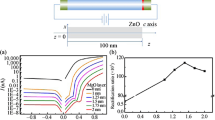Abstract
Small area metal-oxide-metal (MOM) diodes are being investigated in many research groups for the detection of THz frequency radiation. In order to create a high-speed rectifying device, the central oxide layer of the MOM structure must be thin and have known physical characteristics. The thickness, structure and uniformity of the oxide can be controlled during the fabrication process. In the work presented here, the effects of both oxygen plasma concentration and annealing temperature during fabrication of \({\hbox {Ti}/\hbox {TiO}_{x}/\hbox {Pt}}\) MOM diodes have been explored. It has been found that, by reducing the oxygen gas concentration from previous work, the \({\hbox {TiO}_{x}}\) layer can be more repeatable and uniform. Furthermore, for an anneal temperature up to a threshold temperature in the \({200^{\circ }\hbox {C}}\) to \({250^{\circ }\hbox {C}}\) range, the performance of the diodes is excellent, with a value of zero-bias curvature coefficient (CCZB) that can be up to \({4.6\,\hbox {V}^{-1}}\). For higher temperature treatments, the value of CCZB decreases to a maximum of \({2.0\,\hbox {V}^{-1}}\). Similar trends in AC tests can be seen for voltage and current responsivity values.
Similar content being viewed by others
References
E.C. Kinzel, R.L. Brown, J.C. Ginn, B.A. Lail, B.A. Slovick, and G.D. Boreman, Microw. Opt. Technol. Lett. 55, 489 (2013)
E.C. Kinzel, R.L. Brown, J.C. Ginn, B.A. Lail, B.A. Slovick, and G.D. Boreman, Infrared Technol. Appl. XXXIX, vol. 8704 (2013)
J.A. Bean, B. Tiwari, G. Szakmany, G.H. Bernstain, P. Fay, and W. Porod, Infrared Phys. Technol. 53, 182 (2010)
M. Bareiß, A. Hochmeister, G. Jegert, U. Zschieschang, H. Klauk, R. Huber, D. Grundler, W. Porod, B. Fabel, G. Scarpa, and P. Lugli, J. Appl. Phys. 110 (2012)
J.A. Bean, B. Tiwari, G.H. Bernstein, P. Fay, and W. Porod, J. Vac. Sci. Technol. B 27, 11 (2009)
M. Bareiß, D. Kälblein, C. Jirauschek, A. Exner, I. Pavlichenko, B. Lotsch, U. Zschieschang, H. Klauk, G. Scarpa, B. Fabel, W. Porod, and P. Lugli, Appl. Phys. Lett. 101 (2012)
B.M. Kale, Opt. Eng. 24, 267 (1985)
L.E. Dodd, A.J. Gallant, and D. Wood, IET Micro Nano Lett. 8, 476 (2013)
G. Droulers, A. Beaumont, J. Beauvais, and D. Drouin, J. Vac. Sci. Technol. B 29 (2011)
J.A. Bean, A. Weeks, and G.D. Boreman, IEEE J. Quant. Elec. 47, 126 (2011)
S. Krishnan, Y. Emirov, S. Bhansali, E. Stefanakos, and Y. Goswami, Thin Solid Films 518, 3367 (2009)
L.E. Dodd, A.J. Gallant, and D. Wood, IET Micro Nano Lett. 9, 437 (2014)
L.E. Dodd, A.J. Gallant, and D. Wood, Optimizing MOM diode performance via the oxidation technique. Proc. IEEE Sens. 2011, 176–179 (2011)
Author information
Authors and Affiliations
Corresponding author
Rights and permissions
About this article
Cite this article
Dodd, L.E., Shenton, S.A., Gallant, A.J. et al. Improving Metal-Oxide-Metal (MOM) Diode Performance Via the Optimization of the Oxide Layer. J. Electron. Mater. 44, 1361–1366 (2015). https://doi.org/10.1007/s11664-015-3624-9
Received:
Accepted:
Published:
Issue Date:
DOI: https://doi.org/10.1007/s11664-015-3624-9




